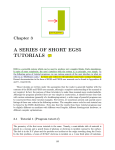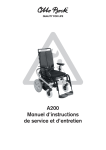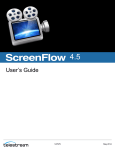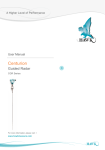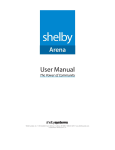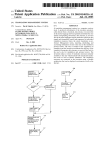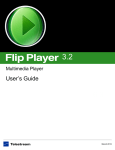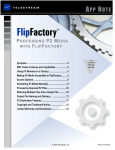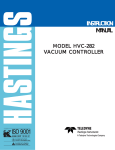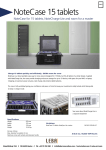Download How to Podcast - University of Arizona
Transcript
--- --- - ----- PLUliliED ncase you haven't noticed , we 're in the middle of some hard economic times. There's really no way to know how long this cur rent economic slump is going to continue or how deep it will ultimately get before the choppy waters begin to recede. But one thing's for sure: it's not a bad idea to revisit what you do and how you do it in order to better serve your own pro fession now and in the future. No matter what your place in the music business: begin ner, enthusiast, or profes sional, it 's vita lly important to use every tool at your disposal to increase your visibility and potential. You might be ask ing: How can I get my musical ideas out to a larger audience? How can I get more people to come out to the clubs to hear my band? What can I do to get more students and to create a better educational experience for them? What can I do to help generate more income from my recordings? How can ...J. I get more session work? I ________ _______________ drummagazine .com June 2009 DRUM! 73 III.IJCiCiI:II III J(q~JLqJ!q~~_~~I ______________________________________ _ There's obviously no single answer to any of these ques tions, but a partial answer to all of them might come from pod casting. In case you haven't experienced one before, a pod cast is really nothing more than a short radio or TV show that's stored on the Net . Many people listen to the radio or watch TV simply for its entertainment value. Others access media to get news, information on prod ucts and services, or to learn If you get creative, you 'll quickly discover there is an infinite number of ways to cre ate a podcast that will get you noticed and let your audience become more familiar with who you are and what you do. Below are just a couple of examples that you might think of as a springboard for your own ideas. about a particular topic that interests them . Your podcasts can offer all of these things to your listeners. What makes a podcast so special is the way that it is delivered to a target audience . While it's possible to create audio and/or video content to post on your web site as a reg ular file or upload to YouTube, people who are interested in your information can choose to subscribe to your podcasts so they can hear or view your programs anytime they choose. Whenever you add new pod casts, your subscribers' podcast program will "feed " the infor mation to them . Working with pod casts is actually a simple two-step process. First, you need to cre ate the podcast. Then you need to post it somewhere on the If you teach private drum lessons , you create podcasts to get additional information out to your students. Short pod cast lessons could be just the thing to keep your cur rent students engaged , and perhaps encourage other drummers to come study with you . Podcasting software lets you combine different types of audio files and edit them individually , making it a snap to have a song playing in the background with an informa tive voiceover explaining a particular concept or technical idea. For example, you might point out "how cleanly and crisply the tom patterns come through the mix," just as the fill moves from the verse to the chorus. Or "notice that mov ing between the top and edge of the cowbell really gives the • Prop4f)Jf1d~ ~~~ + . -'''' _ ... kr•.u .t....... ,-,. l ............... ·&o.w..,~. 1_· What's It All About? h::lotfllllil fUM Vol 14 mmp c..-.".-..,...... rt.~n..,w,._.. ,...... . , .... _ Net so that people can find it and subscribe to it. roottt .. , ........ , ,_... ,t.... ~~' ' .....~ TllU I n.NdITl·)fC ) , 0'1 '" 10' 1·17 l · .,.....,I_· .... '~ .. F' • .,.,~ .... T• .,.._ l_aJ_....... ·'_on ......... .r~'.....t>.F .. ~. fo.c:b .. ' ........ ~," Propaganda is designed from the ground up for podcasting. 74 DRUM! June 2009 drummagazine.com impression of two different in struments ." Your students could receive these lessons automatically via pod cast and could listen to them and review them anytime they wanted. If you play in a band, your fans would love to hear or see clips from some of your recent performances. By getting your best performances out on the Web, you'll strengthen your support base and quite pos sibly recruit new fans . How about using the podcasts to highlight the group's newest songs, publicize upcoming gigs, or offer interviews with the group's members or fans. As a private drum teacher, you could create podcasts that feature different students from your studio. Each podcast might include a short inter view with the student talking about his or her school band program , the kind of music they enjoy, or even hobbies or other interests that they have along with drumming. The podcasts could culminate with the performance of an etude, song, or exercise that they have been working on . A pod cast like this would serve to sharpen a number of important skills for the student as well as help your business. The student would benefit by taking part in the experience of the interview process , while the preparation for the performance portion of the pod cast would be an important goal for which to prepare. Chances are good your students would want to share this podcast with their friends and family , who then might be interested in taking lessons with you or recommending you to their friends . If you're a freelance drum mer, podcasts could be a great way to get your playing out to a larger audience. Your podcasts might include examples of your drumming in various musical styles or performance settings. If you 're a group drummer looking to work with a new band, getting your drumming podcasts in front of the right eyes and ears might just lead to that perfect relationship. The exact content of your own podcasts is variable and entirely up to you. But the end result should be the same: getting your information and your skills out in front of a larger audience . Creatinft Your First Poacast To get started, you 're going to need some software. While there are many programs available for the major com puter platforms, you 'll want to be sure that the software you're using supports a num ber of features that will make your creative process go more smoothly. Look for software that's versatile enough to get source audio material into your com puter easily. You 'll want to have the ability to record from the internal microphone on your computer, an external microphone, a line-in signal, or directly from your com puter 's sound card. If you plan to include remote interviews, you may also look for soft ware that can record an entire voice-over-Internet session. You'll also want to make sure that the software can import audio file s from a CD or mp3. Depending on the materials you want to work with , having the ability to import WAV or AIF files will be very helpful. One popular piece of pod casting software is called Audacity. While it's not the most full-featured program available, it does have a couple of things going for it: For one thing, it runs on all computer platforms. For another, it's free . Abrief Google search will take you to the Audacity web site where you 'll be able to down load the program, read the user manual, and even work with tutorials that will help you understand the program and the audio-editing process. Another common PC pod casting tool is Propaganda . More than a simple audio edi tor, Propaganda is designed from the ground up for pod casting. In fact, once you've created your podcast, a simple push of the "Publish" button will create the pod cast and publish it to your host site. If you have a Mac, creating a pod cast is especially easy. GarageBand comes with all new Macs. And if you 're using an older Mac, you can get the newest version of GarageBand in ilife 09 for less than a ten spot. This one piece of soft ware will do everything you need. When you first boot the program, you can select a "Podcast" project and get to work . You can import audio files, add still photographs , or upload movies into the pod cast. Recording your voiceover material is extremely easy, and like many audio editing pro grams, GarageBand has a good selection of editing features and audio effects that can be applied to the project. Once you've got audio into your computer, you'll have to do some editing. Moving audio around the timeline is essential for a professional-quality pod cast, as is the ability to cut and paste audio tracks. Other useful features to look for are auto matic or programmable gain controls - for ducking tracks and creating special effects that can give your podcasts some sense of place and style. There are several good podcast-creation programs available, each with its own strengths and weaknesses. Several of the programs have demo versions that you can put through the paces before shelling out any cash. And who knows, maybe one of the free software programs might be perfect for you. Some Podcasting Tips You're a professional. Try your best to produce a podcast that has an air of professionalism around it. Get clean audio (no neighborhood dogs barking or babies crying) that's recorded at a strong enough level to hear clearly without any digital clip ping or distortion. If your laptop's onboard microphone is giving you a crappy sound , upgrade to an external mike with better audio quality. Even an inexpen sive microphone could be a big improvement over a built-in model. If you plan to do a lot of voiceover, especially while you're playing, you might con sider a headset mike. Write a script for your pod cast. Until you 're a seasoned pro, don 't try to shoot from the hip. Reading off a script will help you avoid the annoying "uhhhh" passages that are sure to intrude once the red light comes on. Although you can usually edit those out if neces sary, you're better off creating a script to help you organize your thoughts into something that stays coherent and on topic. If you want to go the extra mile, I highly recommend teleprompter software. Sure, you can read the script off your computer screen, but teleprompter programs will also help you with your pacing and keep you relaxed and on track. I've had a good deal of success using a program called Videocue. It's easy to use and includes features that can help produce video podcasts too. Create opening and closing "bumpers. " Short bumpers with a musical theme and introductory information can be very useful to the listener and help creates a branding identity for your podcasts. For the optimal effect, keep them short and focused. And be sure to use original audio material or music that is free of copy right restrictions. Keep your pod cast limited to a single topic. In this age of short attention spans and instant karma, having a five minute podcast covering a single topic in depth is prefer able to a 20-minute session that bounces from one idea to another. However, if it takes 20-30 minutes to thoroughly cover your topic, you shouldn't shy away from longer produc tions, though you may think about breaking it up into a series of bite-sized chunks, which have the added benefit of (hopefully) keeping viewers coming back for more . If your podcast is going to include interviews, plan your questions in advance and share the questions with your guest. That way , they 'll be able to prepare and have a good expe rience with the process. Getting into podcasting is making an investment in your future . I strongly recommend that you commit to mak drummagazine.com June 2009 DRUM! 75 fll.lJCiCil:1I III J(~~JL~J!~~~_~$t _________________________________ _ ing podcasts on a somewhat regular basis. Once a week will likely drive you crazy and con sume a lot of time. A monthly program is a great way to start. It gets you some exposure and offers variety , and your audi ence will get used to hearing from you on a regular basis. When you post your podcast, be sure to include complete and thorough information about your creation. This way, your podcast audience can quickly and easily find you on the Web. It's a big virtual world out there, and you don't want your pod cast to get lost in the chaos. In order to create great pod casts, listen to great podcasts. Agood place to start is on iTunes. Once you open iTunes, go the iTunes store and cl ick on the pod casts label. From there, you'll be able to experi ence some of the most popular podcasts on the Net. Listen to a few of them and take notes about what you liked and what you didn 't like and emulate the aspects you feel would work well on your site. Posting And Hosting As I mentioned earlier, one big advantage of a pod cast is that your audience can sub scribe to future productions. Software programs that bring pod casts to your computer, such as iTunes, Juice , and perhaps a dozen others, will query your host location to see if there are any new pod casts. If new ones are found, the software downloads them immediately. This query hap pens several times a day , so when you create and post a new podcast, your subscrib ers will be able to check it out moments after its creation. You can house your podcast on just about any server, but I suggest you tryout one of the services that specializes in hosting podca sts . Online services such as Liberated Syndication, Pod Bus, Podblaze, AudioBlog. and others will not only host your podcast, they 'll keep track of the podcast's activity and offer reports on the number of subscribers and other data you might find interesting or helpful. A great tool for creating your RSS podcast is called Feedburner. Feedburner will manage your RSS feed for you. RSS stands for Really Simple Syndication, and it's the brains behind the subscription mechanism . Feedburner was recently acquired by Google , and according to their FAQ, it's designed to "help publishers promote, deliver, and monetize their content on the Web and make feed-based content more accessible and manageable for its end users ." 76 DRUM! June 2009 drumma gdZine.com If you wish to get your pod casts out to the maximum number of people , consider submitting them to the iTunes Directory. Not every pod cast is available through the iTunes store, but it certainly has the largest inventory of pod casts and the largest number of eyes and ears searching through podcasts for interesting con tent. It's really pretty easy, and as long as your podcast doesn't contain copyrighted materials that don't belong to you or too many explicit materials , it is likely that your podcast will be accepted into the directory . Final Thoughts While the software and meth ods covered here apply mainly to audio pod casts, video pod casts are getting more and more popular and easier to create. I would suggest start ing with a few audio pod casts before venturing into the video waters, but certainly for some situations, video podcasts would be the way to go . Creating and publishing pod casts can certainly be a plus for any musician . While getting started might be a little confusing, you'll soon find it fun and rewarding. I might suggest that you search the Web for additional information. There are a number of excel lent tutorials and ideas that can make your initial plunge into the podcasting world as smooth as silk . In fact , there are plenty of podcasts about podcasting! Give them a listen and get going. U 'Special thanks to MAR K COOK MM candidate at the University Of Arizona. for IllS help in researching Inforlllation In the article. SOFTWARE SITES PROPAGANDA makepropaganda.com VlDEOCUI varasOflWare;i::IMt





